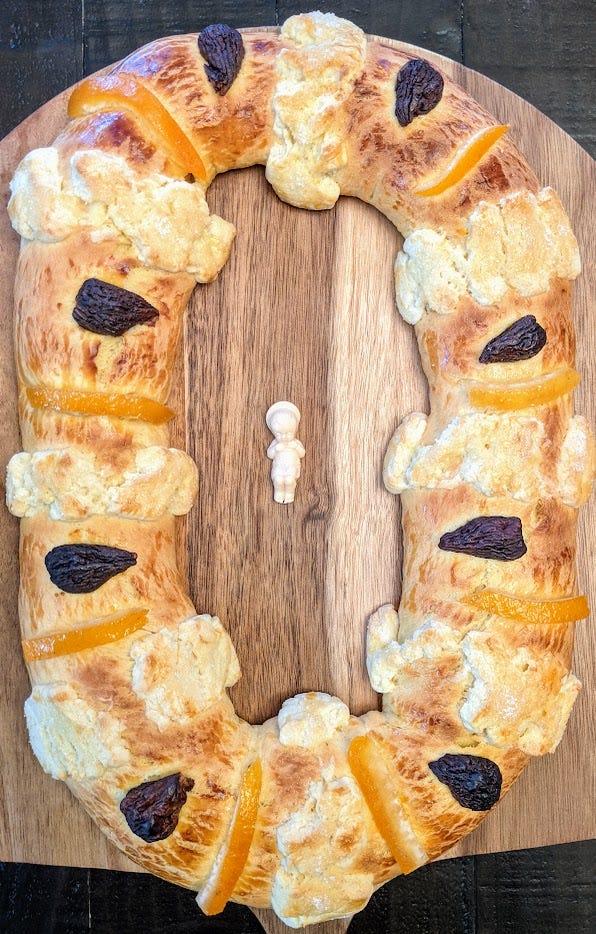Hello friends! This is Peregrino, a newsletter about the journey. Today, I bring a special edition on Día de los Reyes Magos, a.k.a. Epiphany. If you’re new here, welcome! It’s good to have you. If you haven’t subscribed, I will make it easy for you to do so.
Circa 1990, Mexicans began to refer to the time spanning from December 12th to January 6th as the Guadalupe-Reyes Marathon. A festive season that kicks off with the celebration of our Lady of Guadalupe goes through Las Posadas, Nochebuena (Christmas Eve), Christmas Day, Holy Innocents’ Day (Mexico’s version of April Fools), New Year’s Eve, New Year’s Day and closing with Dia de los Reyes Magos (the feast of the Epiphany).
Every January 6th, we would gather at my grandparents’ house and eat Rosca de Reyes, drink hot chocolate, and enjoy each other’s company. It’s what you did to celebrate that day. But why? Where did the tradition come from? Why is it an oval? Why does it have candied fruit on top? Why do we hide baby Jesus figurines inside? Is there a meaning behind all of these things?
To answer these questions, we must travel back to 19th-century Europe, where people started baking “King cakes” to be eaten during the feast of the Epiphany. France came up with galette de rois in the north, a puff pastry filled with frangipane and gâteau de rois in the south, made from a soft white dough shaped as an oval, resembling a crown, with raisins, nuts, and crystalized fruit, symbolizing jewels. A small fava bean would be hidden in the cake, and whoever found it would either win a prize, have to buy a round of drinks, or be declared king for the day, depending on the place’s tradition.
Spain came out with their Roscón de Reyes, similar to the gâteau de rois, but with figs, quinces, and cherries in addition to the candied fruit. The Spanish brought this tradition to Mexico and Latin America. In Mexico, Rosca de Reyes is made of a sweet brioche dough with orange blossom water. The fava bean has been replaced with plastic figurines of baby Jesus. Hiding baby Jesus in the bread represents the flight of the Holy Family to Egypt, fleeing from Herod the Great’s massacre of the Holy Innocents.
Even though the Epiphany marks the end of the Christmas season, tradition says that whoever gets baby Jesus in their slice of rosca is meant to throw a party on February 2nd, Día de la Candelaria (Candlemas). If you are my grandma, this marks the official end of the Christmas season and when the niño Dios is put away until next year with the tree, the nativity, and the rest of the Christmas decorations. In a way, this could be considered an expansion pack of the Guadalupe-Reyes marathon.
Aside from Rosca de Reyes, in places like Mexico City, it is common for kids to take pictures with the Three Wise Men in shopping malls, just like kids in the US take photos with Santa. My family tradition for Día de Reyes included leaving a shoe by a window in hopes of receiving a small gift from the Magi, like chocolate “gold” coins or a candy bar.
Whether you wrap up the Christmas season by Epiphany or want to prolong the Christmas cheer until Candlemas, find the closest Mexican bakery, get yourself a Rosca de Reyes, and spend quality time with the family. Consider finding a baby Jesus in your slice as a blessing and decide if you’ll get together again on February 2nd.
Before you go
I have some questions for you.
Have you had Rosca de Reyes before?
Did the Magi bring gifts to you as a kid?
When do you wrap up the Christmas season?






That’s such a beautiful tradition! In the traditional liturgical calendar (the one that the Latin Mass uses today), the Christmas season doesn’t end until Candlemas. Like your grandmother, my family and I keep all our Christmas decorations up through Candlemas. It’s an excuse to enjoy them for longer and it’s keeping traditional Catholicism alive, so I consider it a win all around.
My family did not always have a Rosca de Reyes, since this tradition is not really found in Cuban homes. However, my parents always saved one of our Christmas gifts for Los Tres Reyes. Even if it was a school day, we'd take a minute to unwrap a gift from the three kings.
I have tried to make a rosca myself, and oh boy I was way over my head! 😅 Now I try to just buy one from a local store.
As for the Christmas decorations, they are put away usually the weekend after Los Tres Reyes.